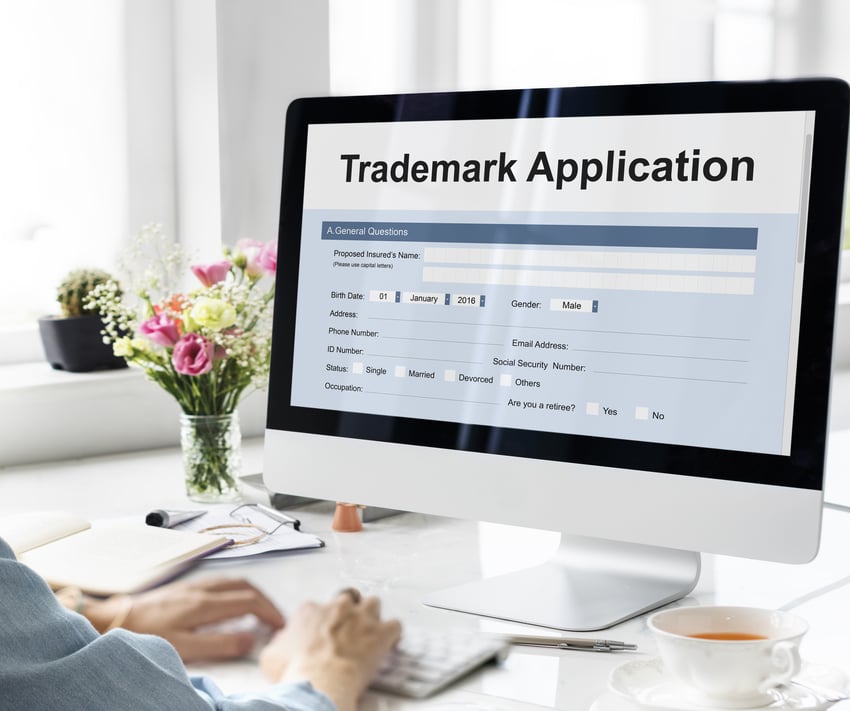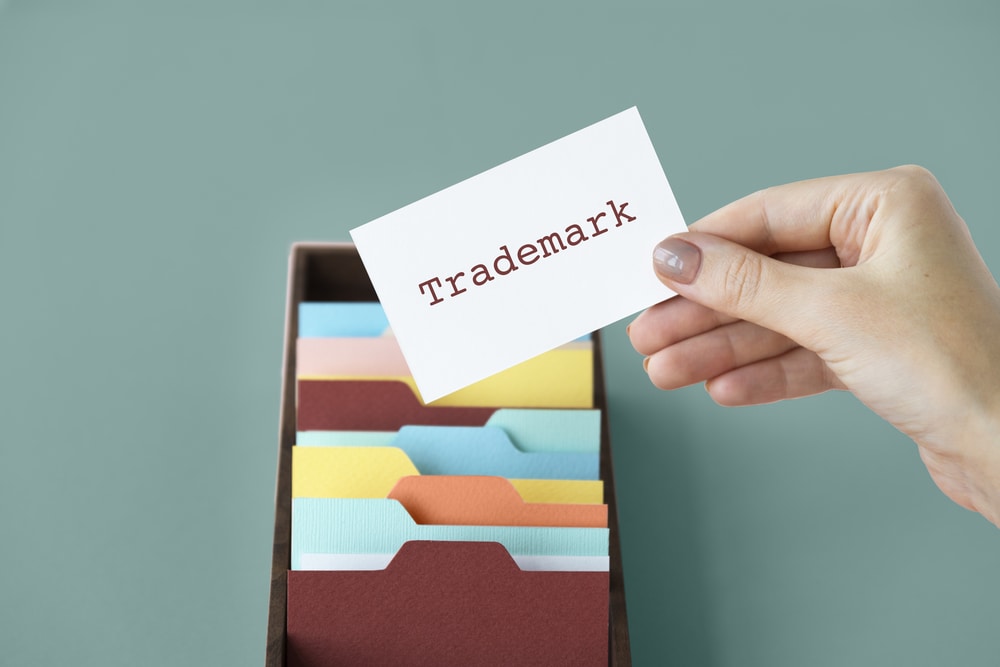Once you have decided on the right logo for your business, there’s a good chance that you have invested a good deal of time, thought, and possibly money into the project. Creating a unique logo design for your business helps to stand your brand out against the competition, making it recognizable and distinctive to your offerings. It’s exciting to finalize a logo design, but before you run with it, it’s important that you trademark it for protection. But where to start? Here is a complete, step-by-step guide for trademarking a logo.

What is a trademark?
A trademark represents an intellectual property in the form of a unique symbol or series of words that is used to represent a brand, business entity, and/or its specific products. Once it is registered, a trademark provides legal protection regarding its use. There are three levels of trademark protection available. These are:
Local trademarks
As soon as you start using your logo commercially, you are automatically afforded some protections under common law within your region. To use a logo commercially requires you to have sold a product or service while utilizing it, not just displaying it in the hope of making a sale. There are two marks used to assert such protections, these are ™ and SM. ™ is the trademark symbol used for goods, and SM is the mark used for services. Both of these symbols represent an assertion of legal authority regarding the use of the logo. They do not, however, indicate that any protection has been obtained at a state or federal level. Aside from commercially utilizing your logo, there are no other actions or costs involved in holding Common law trademarks. They can protect you effectively when it comes to lawsuits within your regional jurisdiction, but it’s less likely that you will win a lawsuit against anyone who tries to copy your logo outside of that area.
State trademarks
If your business plan strictly outlines the intention to trade only within your state, then a state-level trademark may suffice. State trademarks are usually processed by the office of the secretary of state in which you intend to conduct your business, and such registration affords you legal protection within that state alone. This is a cheaper and less complex option than federal trademarking, but, like a local one, a state trademark does still limit your protection to a particular geographic location. The costs for obtaining a state-level trademark differ between states, but typically range from $50 - $70. You can find out more on your particular state’s official website.
Federal trademarks
The highest level of protection you can get is by registering a federal trademark. This is the most expensive and complex process but is the only way to ensure that you have full trademark protection throughout the US and potentially the world. Federal trademarks are issued by the U.S. Patent and Trademark Office (USPTO). The exercise of obtaining one can be complicated, and some people prefer to put the process in the hands of a trademark lawyer or other online legal service. Such services can help to ensure that you correctly submit your applications and assist with any other queries or concerns you may have. When a logo application is approved, the USPTO places it on the Principal Register. This listing grants the owner: • Legal ownership, as well as exclusive use of the registered logo throughout the U.S. • The right to file a federal lawsuit against any party who attempts to infringe upon those rights, as well as the right to collect damages resulting from successful suits • The right to register the same trademark in other countries • The authority to request that U.S. Customs and Border Protection confiscates any imports bearing the logo that have not been authorized by the trademark owner • The right to display the federal trademark Ⓡ symbol beside the registered logo
When it comes to the cost of obtaining a federal trademark, there are a variety of fees that may be applicable. The initial electronic application filing fees are $225 for TEAS Plus, and $275 for TEAS Standard. Essentially, TEAS Plus is a little cheaper, but more submissions will be required than the TEAS Standard option. In addition to the initial filing fees, other factors may alter the final overall cost, such as the number of classes required and corrections that need to be made. For example, the fee for making a required correction is $100 per class applied under, so depending on how many classes your products cover, the final amount could be significant.

This is why many business owners opt to engage the services of a trademark lawyer and outsource the work. Their fees vary, but typically fall within the range of $1,000 and $2,000 on top of the initial filing fee.
How to get your logo USPTO trademarked
1. Ensure your logo meets the USPTO requirements
Whenever you embark on a new business venture, it is prudent to consider the legal aspects of starting a small business, and this includes branding it uniquely to avoid any legal and financial implications. To be eligible for trademarking, a logo must not be too similar or identical to one that is already in use. You, or your appointed legal services, can determine whether your logo is unique by searching the USPTO’s trademark database. According to the USPTO, one of the most common issues with logo registrations is the extent of similarities with an existing trademark, and registration rejection then falls under the reason of ‘likelihood of confusion.’ The USPTO will also reject any logo applications that are deemed offensive or misleading. No profanities or obscenities will be tolerated, and any logos that don’t clearly represent the intended product or service type will be turned down, too.2. Choose your category carefully
The next step is to categorize your product/service related to your logo application from the 45 USPTO categories available. In order for your application to be successful, it is imperative that you choose the most appropriate category based on your products and services, and that your logo corresponds to that category clearly. It can help to obtain some professional guidance on this if you are in any way unsure.3. Prepare a commercial example
The USPTO will require you to provide them with a ‘specimen’, otherwise known as a commercial example of how your logo will be used. If your business intends to add the logo to a product, you will need to provide images of the logo on one of your products, printed on tags or product packaging, and/or a store display that features your logo design. If you trade in products, It is not sufficient to provide specimens on marketing materials or similar, such as business cards, brochures, or newsletters, as these do not feature the logo in its commercial capacity. As a service provider, however, marketing or stationary materials or website screenshots bearing your logo will suffice. You are required to submit a commercial specimen for each type of service or product that will be associated with your logo.4. File the application and be patient
Once you have completed these steps and your application has been filed, you should receive an acknowledgment from the USPTO straight away. The outcome, however, may take several months, and in some cases - particularly if any issues arise - the process could take up to a year, occasionally longer. It is common not to hear from the USPTO during this time, except in the case of any issues requiring a resolution. While you wait, however, you can check your application’s status via the Trademark Status Document Retrieval Database, using the serial number provided to you on your lodgement receipt. This site can also advise you of the average processing times currently applicable.5. Resolve any issues if they arise
If you receive a rejection based on a resolvable regulatory or administrative issue, you will be given the opportunity to rectify the problem. Alternatively, you could receive an Office Action, which will allow you up to six months to make the required corrections. If the revised submission is still not deemed satisfactory, you will be given a final refusal, which you can appeal via the Trademark Trial and Appeal Board (TTAB). This will, however, result in additional fees. If the USPTO rejects your submission on the grounds of similarity to an existing trademark or another inherent logo flaw, you will have to return to the design stage to ensure that your logo is eligible before re-applying.
6. Approval
Once your application is approved, your logo will be listed in the USPTO’s Official Gazette. This essentially means that your logo is publicly noted as pending federal trademark status, and anyone who wishes to contest it will have 30 days to do so. So long as no one believes that their business could be harmed by your logo being trademarked (which is unlikely), then your logo will become a registered trademark and be given all of the associated federal protections and rights.Maintaining your trademark status
Once you hold a federally registered trademark, you will need to maintain this status every five years, by submitting a Trademark Renewal and a Trademark Declaration of Continued Use to the USPTO. If you fail to do this, the department will grant you a grace period of six months to file the documents, but fees will apply. If the additional six months pass and you do not submit these continuance forms, the USPTO will mark your logo as permanently abandoned and all associated protections and rights will cease.
Key Takeaway: Why Trademark A Logo?
Generally speaking, unless you are planning on solely trading within your local jurisdiction, it pays to obtain a state or federal trademark for ultimate protection. If the logo, symbol, or phrase you want to use is seemingly non-trademark-able, you may be able to achieve trademark status via a secondary meaning trademark, meaning that the public begins to identify it with your particular product or service regardless. Growth Hackers is a growth hacking, inbound and outbound marketing agency helping startups, entrepreneurs, and business owners with branding, digital marketing, and growth hacking. We can help you build your overall growth strategy, whether for an existing business or a new venture. Contact Growth Hackers today if you want to use growth hacking techniques that will set your business for success.





1 Comment
Hey Denise Langenegger,
Aadarsh this side. You have shred an excellent article to trademark a logo. You have explained and presented all the essential tings in such a step-by-step process guide making a concept very clear and easy to understand. while scrolling through this blog post i have noticed that you have also discussed about trademark and its various categories that are really providing a good understanding. Your each mentioned steps to get the logo USPTO trademarked are so clear, well-elaborated and must be considered while doing so.
After going through this complete guide i got ideas and am sure that this informative post will definitely help lots of people, readers to sort-out their query.
Truly helpful post and keep sharing more similar post.
Thanks,
-Aadarsh